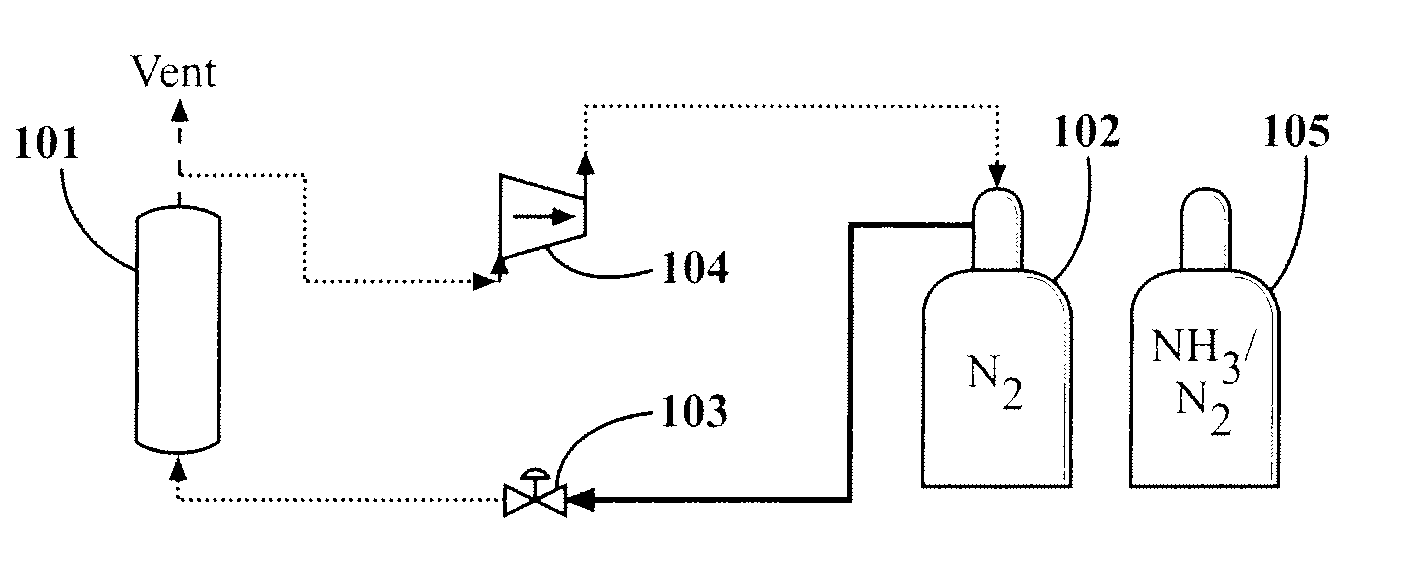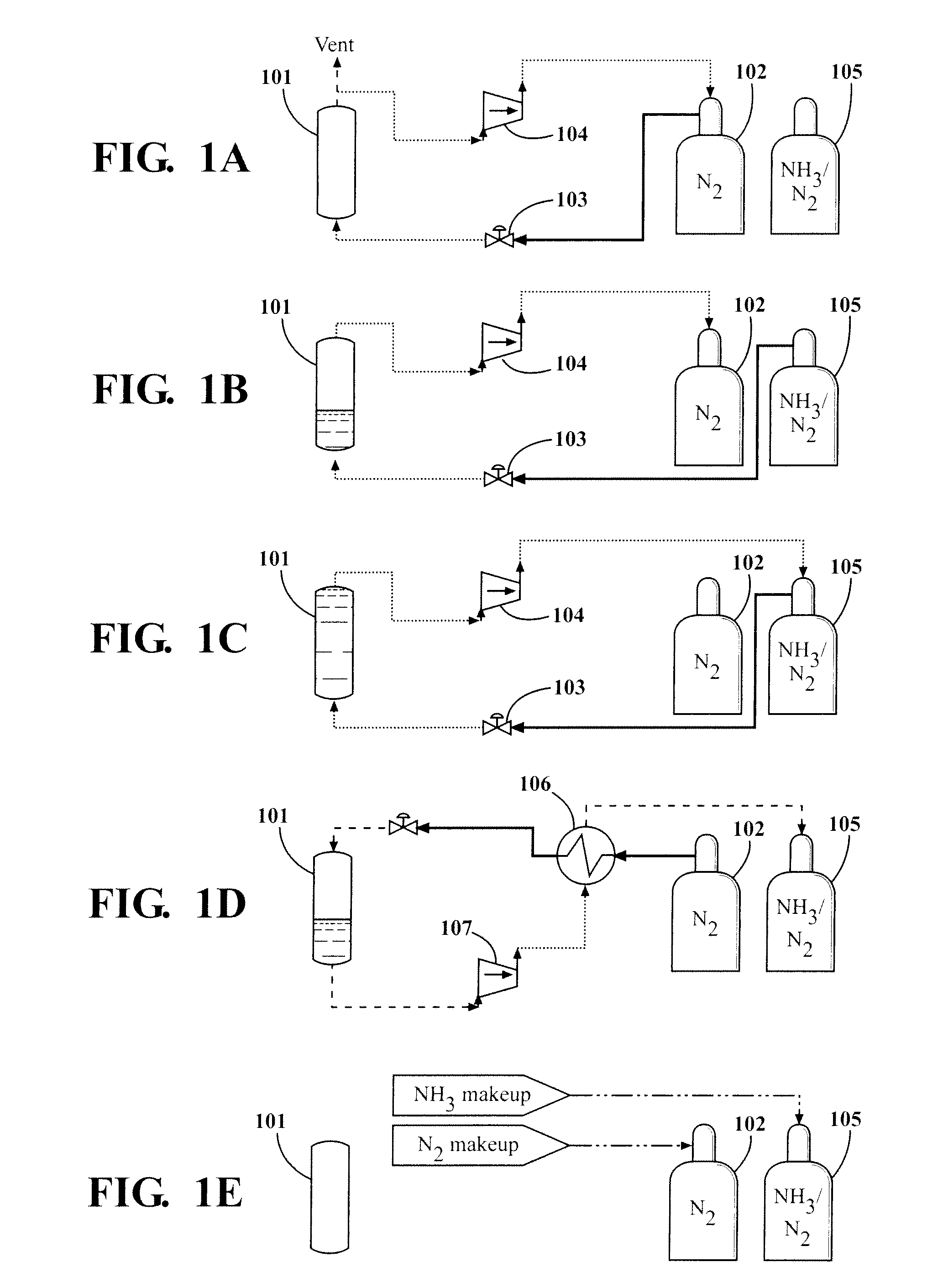Method of separating components from a gas stream
a technology of gas stream and components, applied in the direction of separation process, glucose production, finely divided material pretreatment, etc., can solve the problems of high cost of adsorbents used in gas-solid separation, high cost of distillation equipment, and high cost of skilled operators
- Summary
- Abstract
- Description
- Claims
- Application Information
AI Technical Summary
Benefits of technology
Problems solved by technology
Method used
Image
Examples
example 1
[0092]One embodiment of the invention is shown in FIGS. 1A-1E, which uses a single vessel for gas component separation. As shown in FIG. 1A, a vessel containing biomass material 101 is swept with a water insoluble gas (e.g., nitrogen) from a tank 102 to eliminate air to vent, then the vessel is pressurized. Pressure is controlled with a pressure regulator valve 103, with recirculation provided by compressor 104.
[0093]In FIG. 1B, a gas feed stream comprised of a mix of a first gas component (e.g., ammonia) and a second gas component (e.g., nitrogen) is sent from a tank 105 to the vessel 101. In the vessel 101, the first gas component is separated from the second gas component by absorption. As absorption is taking place, the second gas component continues to flow through the vessel 101. The second gas component leaves the vessel 101 and is sent to the compressor 104, and to the tank 102.
[0094]In FIG. 1C, breakthrough of the at least first gas component is detected by the temperature ...
example 2
[0097]One embodiment of the invention is exemplified in FIG. 2. In this embodiment, three vessels containing biomass material 201a-c are arranged in series.
[0098]In FIG. 2A, water insoluble gas (e.g., nitrogen) is supplied from a tank 210 to the vessels by way of a compressor 211. Pressure is regulated by back pressure regulator 212.
[0099]In FIG. 2B, vessel 201a is charged with water soluble gas (e.g., ammonia) from vessel 213 as the water insoluble gas continues to be circulated by way of compressor 211. The gases are mixed at the influent end of vessel 201a and feed to vessel 201a is continued in this manner until the biomass material is determined to be desirably saturated with water soluble gas. At such point, a breakthrough of water soluble gas is observed at the effluent end of the vessel 201a, and flow of the water soluble gas to the vessel is ceased. Any quantity of water soluble gas present in the effluent from vessel 201a is absorbed at the influent end of vessel 201b. The...
example 3
[0105]Gas Separation Using a Packed Bed of Moist Wheat Straw as Biomass Material.
[0106]Wheat straw was ground to 2 mm maximum particle diameter. The moisture content of the ground straw was adjusted to 47 wt %. A stainless steel vessel, 53 cm in length, 3.5 cm internal diameter, 510 cubic centimeters internal volume, was packed with 91.0 grams of the ground, moist wheat straw. The vessel contained 48.0 grams of wheat straw dry matter and 43.0 grams of absorbed moisture. The vessel was packed by dumping the moist straw into the vessel, then tapping the outside of the vessel until no further settling of the biomass bed was observed. The bed was supported with 150-mesh stainless steel screen at both ends of the vessel. The vessel was then sealed, nitrogen circulated, and the vessel pressurized to 79±1 psig. Nitrogen sweep flow of 534 standard cubic centimeters per minute (sccm) was established through the pressurized vessel containing the packed straw, with the effluent sweep gas passi...
PUM
| Property | Measurement | Unit |
|---|---|---|
| temperature | aaaaa | aaaaa |
| particle size | aaaaa | aaaaa |
| particle size | aaaaa | aaaaa |
Abstract
Description
Claims
Application Information
 Login to View More
Login to View More - Generate Ideas
- Intellectual Property
- Life Sciences
- Materials
- Tech Scout
- Unparalleled Data Quality
- Higher Quality Content
- 60% Fewer Hallucinations
Browse by: Latest US Patents, China's latest patents, Technical Efficacy Thesaurus, Application Domain, Technology Topic, Popular Technical Reports.
© 2025 PatSnap. All rights reserved.Legal|Privacy policy|Modern Slavery Act Transparency Statement|Sitemap|About US| Contact US: help@patsnap.com



